Observing the “D” dock pump out station is quite educational; sometimes its down right humorous. There are only two sides to the dock, which pretty much limits the number of docking options. The north side of the dock (typically the leeward side) is pretty straight forward. There is clear water all around, and it’s just a matter of pulling up to the dock and using one or more lines to keep from blowing away. Most of the fun happens on the south side of the dock! That’s are area bounded on three sides by the pump out dock, the cross dock, and the row of boats. When you really think about it, there are only two options available to dock there. Either pull straight in using forward or back in using astern propulsion. Which option generally depends on which side of the boat the waste cap is on. Waste cap to port? Pull straight in and lay the port side of t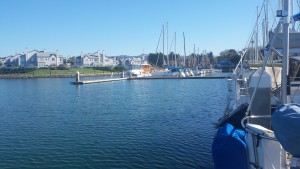 he boat against the dock. Waste cap to starboard? Back in and lay the starboard side against the dock. What could be simpler?
he boat against the dock. Waste cap to starboard? Back in and lay the starboard side against the dock. What could be simpler?
With things as simple as that, why do you see people trying to complete “U turns” inside the area bounded on three sides by the dock, cross dock, and a row of boats? With that question in mind, here are a few techniques to make docking at the D Dock pump out station safe, easy, and not entertainment worthy.
The first thing to keep in mind; if you go in frontwards, depart backwards. If you approach backwards, depart frontwards. On a typical Marina Bay day, the wind will push t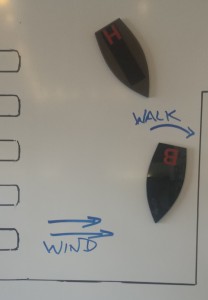 he boat towards the dock. Let it help. Approach at a slight angle to the dock. As you get close, turn slightly away from the dock. Try to end up two or three feet away from the dock with the bow slightly to windward. Assuming port prop walk, when you go into reverse the prop walk will tend to bring the stern towards the dock and the wind will push the bow in. Get a line to the dock fro
he boat towards the dock. Let it help. Approach at a slight angle to the dock. As you get close, turn slightly away from the dock. Try to end up two or three feet away from the dock with the bow slightly to windward. Assuming port prop walk, when you go into reverse the prop walk will tend to bring the stern towards the dock and the wind will push the bow in. Get a line to the dock fro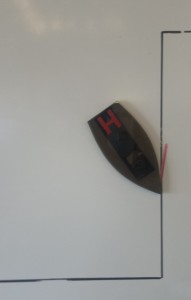 m the stern and you are good. If there is any wind, the bow is held in place from wind pressure.
m the stern and you are good. If there is any wind, the bow is held in place from wind pressure.
Too depart, use a dock line with no knots, loops, or eye splices. The line should go
from the bow of the boat, around a cleat on the dock, and back to the bow of the boat. Place the boat in forward at a low RPM with the wheel turned slightly to the dock. The force of the bow line and prop wash moves the stern away slowly away from the dock. When enough of an angle has be achieved, reverse away from the dock, making sure the bow line is clear.
Coming 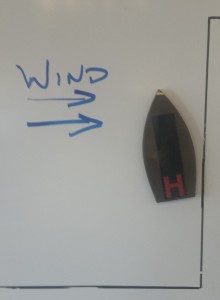 into the dock in reverse is essentially the same. Go into reverse well clear of everything. Back within two to three feet of
into the dock in reverse is essentially the same. Go into reverse well clear of everything. Back within two to three feet of 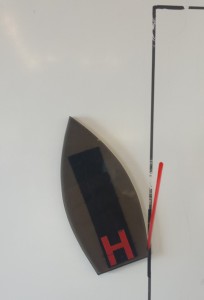 the dock then bring the boat to a stop with the bow slightly to
the dock then bring the boat to a stop with the bow slightly to
windward. Let the wind finish the docking. Again, get a stern line ashore and let the wind take care of the bow.
To depart, back up on a spring line running forward from the stern. When the bow has a sufficient angle off the dock, go forward carefully while releasing the line. Turning the wheel slightly into the dock when transitioning into forward moves the stern clear of the dock. Immediately straighten the wheel to depart.
These two simple docking/departure techniques are all you need for successful windward docking at the D dock pump out station. No more do you need to attempt nearly impossible turns in limited space! Instead, you can sit back and enjoy the entertainment others offer. Next time, we’ll look at docking techniques for the leeward side.

It’s all so simple when you read it! Unfortunately, I can’t read and steer at the same time. 😉
Hey Don
I tried backing in one windy day and found that I couldn’t maintain a straight approach to the dock – the cross wind was pushing on the bow, making the boat back in “crab like”.. I ended up abandoning the approach and docking on the leeward side.
Any thoughts on maintaining a straight backup on a windy day?
Cheers, Tim
Unfortunately, I’m not sure there is a single thing that can be done in a case like you have described. Every boat is going to handle the situation differently.
Here are a few thoughts that might work.
A bit more speed might give you the steerage you need to offset the bow wanting to blow down. Be careful when adding speed. Its very easy to add too much and end up out of control in a confined area.
If the wind if coming from the port side, both wind and prop walk are conspiring to “move” the bow to starboard. A bit of starboard rudder helps to offset it. The same holds true if the wind is from starboard, however, you probably don’t need as much port rudder because prop walk will be helping you.
One final thought. Its easier to maintain a straight course once a steady course and speed is set. Transition from forward to reverse well away from everything to give yourself time to obtain total control before backing into close quarters.